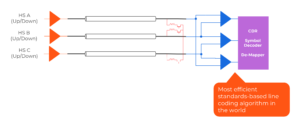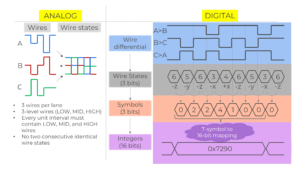
Technical Insights
C-PHY v2.0: Defining Key Insights
3 min

The MIPI Alliance just released version 3.0 of the MIPI C-PHY™ specification. What is this release about and why is it important? Read on to learn about the MIPI C-PHY™ version 3.0. But first, let us remind ourselves about the original C-PHY specification.
Introspect Technology has been part of the C-PHY journey since the very beginning of its invention and definition. Referring to our 2014 press release about this incredible specification, we stated that “C-PHY is an emerging physical layer standard that allows for significant bandwidth improvements on constrained transmission channels such as those found inside mobile terminals.”
Indeed, the C-PHY physical layer (PHY) has two main defining features that enable it to produce the most efficient standards-based signal transmission system in the world. These are described in the following sections.
Figure 1 shows the wiring topology of a C-PHY lane. As can be seen, instead of a differential pair with a P wire and a N wire, the C-PHY lane consists of 3 wires, and these are often labeled A, B, and C. These 3 wires act together to make a lane. That is, just like the P and N wires of a differential pair are expected to work in conjunction with each other (specifically, one wire switches in a complementary manner relative to the other wire), the A, B, and C wires must work together. The C-PHY specification defines how these wires work together.

One key strength of the C-PHY specification is that it does not require a separate clock signal to be transmitted between a transmitting device and a receiving device. This is achieved by a signaling method called “three-phase”, and Figure 2 shows a nice infographic that summarizes how this signaling scheme works.

Without getting into details about three-phase signaling, you can see from the infographic in Figure 2 that it has the following properties:
The genius in the original C-PHY specification is that it can achieve an encoding efficiency of 2.2857 bits per unit interval (UI). This is very high efficiency. For example, it is better than PAM4, which achieves 2 bits per UI but requires 4 signal levels instead of only 3 in C-PHY.
Here is what to expect from the version 3.0 release of the MIPI C-PHY™ specification:
The above changes mean that C-PHY v3.0 can now achieve a whopping 3.556 bits per UI coding efficiency. This in turn enables system implementers to run the C-PHY links at low symbol rates, thus reducing EMI and power consumption without sacrificing bandwidth.
Introspect’s C Series products, such as our SV5C-DPTXCPTX MIPI D-PHY and C-PHY Generator, are equipped with the latest capabilities to help you test your receivers. Are you planning to implement C-PHY v3.0 in your next camera, imaging, or automotive link? Let us know by writing to us at info@introspect.ca and learning about Introspect’s capabilities and roadmap for C-PHY 3.0.
Having worked in lockstep with the MIPI Alliance for over 10 years, we’re proud to continue our efforts to develop cutting edge MIPI solutions. For an in-depth look at the MIPI C-PHY™ basics, learn from Dr. Mohamed Hafed, Chief Executive Officer of Introspect Technology, in this presentation held at MIPI DevCon in Bangalore, India. It’s MIPI’s most viewed video!
